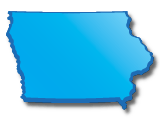
Iowa ranks fifth in the nation for per capita energy consumption. That’s a lot of energy. But the predominately agricultural state uses a lot of liquid fuel for maintaining those food production operations, which the Energy Information Administration counts in total consumption. Perhaps the more surprising statistic is that the state gets almost 27 percent of its electricity from wind. In fact, wind is second only to coal in the state as a source of electricity generation. With a strong wind energy market, the state is relatively green even as it ranks only 23 in terms of solar policy. While Iowa promotes renewable energy and solar power, the policies aren’t particularly robust, which hasn’t resulted in big industry growth.
Still, the state’s low- and no-interest rate loans, rebate programs, tax incentives, performance-based incentives and other programs have promoted some solar installations.
The state established the Iowa Office of Energy Independence in the early 2000s. The office is charged with producing the state’s annual Energy Independence plan and manages the Iowa Power Fund, which helps finance clean energy development in the state.
While not technically called a renewable energy portfolio standard, Iowa became the first state in the country to require its investor-owned utilities to get a certain percentage of their power from renewable sources when it passed its alternative energy law in 1983. The two utilities combined are required to source 105 megawatts of electricity from renewable sources.
